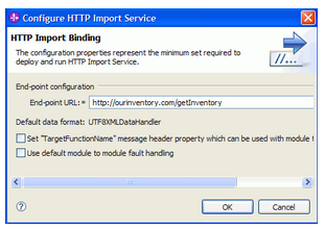Before you begin
Prerequisite: You should have a module. The module should have an import with an interface.
About this task
In this set of steps, you will learn how you create an HTTP binding for an import. This popular protocol is used in many circumstances. It is often used by a Web service.If you intend to use the predefined HTTP bytes data binding then you must use the following schema and data handler. Under Predefined Resourcesin the Dependencies editor, select Native Body schema for Native Body DataHandler. Save your work and close the dependencies editor.
If you intend to use the predefined HTTP bytes data binding with a static service gateway then you must also add the service gateway interface and schema files. To add this interface and schema files to your module, open the dependencies editor. Under Predefined Resources, select Service gateway interface and schema files. Save your work and close the dependencies editor.
Procedure
- Open the assembly editor. Under Outbound Imports, select HTTP and drag it to the assembly editor. Select an interface or create one.Alternately, from the palette under Components, select an import and drag it on to the canvas. An import with no implementation and no interface is created. Right-click the import, select Add Interface from the context menu and add an interface describing your interaction with a client. Generate the HTTP binding by selecting the import and from the context menu selecting Generate Binding > HTTP Binding.
- The Configure HTTP Import Service dialog box opens.
- In the End-point configuration section, enter the Uniform Resource Locator (URL) your binding will request data from.
In the Default data format field, select how the data will be serialized between the business object and the HTTP message with a binding. To change the default, click Select beside the field to launch the Data Transformation Configuration window. Your selections are as follows:- Use a data format transformation in the binding registry. This list includes the prepackaged HTTP data format transformations. SelectingShow the deprecated data format transformations adds previous transformations that have been deprecated.
- Use a custom data format transformation you have created in your workspace
- Create a new data format transformation configuration.
In the next section, if you wish to use the TargetFunctionName message header property to be used with module to module communication, select it. If you wish to use the default module to module fault handling, which is a SOAP transport, select it.
Click OK. The HTTP binding is created and shown in the properties view when the Binding tab is selected. Sub tabs under the binding tab provide binding information details, which are discussed in the next steps.
The HTTP binding is complete as is with some qualifications:- The interface has only a single operation or, if it has more than one operation, they all use the same URL address.
- The target service is not using the Secure Sockets Layer (SSL) and does not require basic authentication.
- The request and, if necessary, response does not need to use a proxy.
- The target service does not need any special headers to be set up.
- The target service can be called with the default HTTP method preselected by the handler based on the set of assumptions derived from the interface structure.
- In the Properties view, selecting the Binding tab displays the service level configuration properties, which can be edited as discussed previously. The endpoint URL and data binding configuration are shown. Note that the URL at the method binding level will override this URL.The HTTP version and HTTP method, GET by default in a two-way operation and POST in a one-way operation, are shown. The HTTP methods available are: DELETE, GET, HEAD, OPTIONS, POST, PUT, TRACE. A description of the binding may be added.
- Advanced configuration has the same tabs as described in the next step - HTTP Headers, HTTP Proxy, Security and Performance - but sets the values in these containers at the service level; that is, for the entire service. Method binding properties take precedence over these ones.
- Selecting Method bindings and the Generic tab displays the method level properties that can be edited. The properties list the endpoint URL, HTTP method and version and provide a field for a method binding description. These properties only apply to the method level and changing them will only affect the method level, not the entire service. All method level binding properties override the binding level properties.In the next section, if you wish to use the TargetFunctionName message header property to be used with module to module communication, select it. If you wish to use the default module to module fault handling, which is a SOAP transport, select it.
The Data Serialization tab lets you change the input and output data binding configuration.
Selecting the HTTP Headers tab lets you choose the transport and content encoding. Defaults are provided, but you can select different types of compression for the content and use chunking for an alternate transfer method. There are a range of media types and character sets that are displayed in drop-down lists. The HTTP 1.1 specification discusses these header fields in detail. The TargetFunctionName header value is displayed. This value corresponds to the operation that should be invoked on the application that is being called by the import.
Proxy servers service the requests of clients. If you wish to use a proxy server, the HTTP Proxy tab presents fields for the host name, port and security attributes.
The Security tab lets you add a Secure Sockets Layer (SSL) authentication alias and a basic authentication alias. These aliases need to be configured on the server manually to work as they are not created on the deployment of your service.
The Performance tab lets you set a timeout value and number of retries value to minimize lengthy delays at runtime. - Selecting the Faults configuration tab lets you configure the faults specified on the operations in the interface. The configuration of faults is optional. The configuration can apply to all operations or a specific operation.If fault configuration is new to you, see Handling faults in bindings for an overview.
Click Select beside Fault selector to configure a fault. Your selections are as follows:- Use a fault selector in the binding registry. This list includes the prepackaged HTTP fault selectors.
- Use a custom fault selector you have created in your workspace
- Create a new fault selector resource configuration.
- Use a data format transformation in the binding registry. This list includes the prepackaged HTTP data format transformations.
- Use a custom data format transformation you have created in your workspace
- Create a new data format transformation configuration .
- The Propagation tab lets you select two types of context propagation. Context propagation takes information associated with a runtime or an application and passes it along with requests that are the result of interactions with that runtime or application. The default is to use runtime context propagation. See Propagation.
- The Summary page maps a method on the interface to a URL address that the application will call when the import is invoked with this method.
For training on IBM Lombardi mail us at [email protected]


 RSS Feed
RSS Feed



